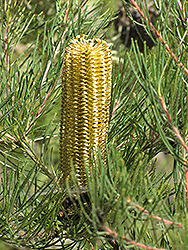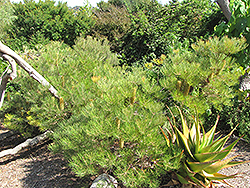It's all about ...
plants

Cunningham's Banksia
Banksia spinulosa var. cunninghamii
Height: 15 feet
Spread: 20 feet
Sunlight:
![]()
Hardiness Zone: 8b
Description:
A large, upright shrub presenting needle-like, dark green leaves with silvery undersides; magnificent, candle-like yellow spikes in autumn, persist into winter and spring; a drought and frost tolerant plant that does well in coastal environments
Ornamental Features
Cunningham's Banksia features showy spikes of yellow pincushion flowers along the branches from late fall to early winter. The flowers are excellent for cutting. It has attractive dark green foliage with silver undersides. The needles are highly ornamental and remain dark green throughout the winter. The smooth gray bark adds an interesting dimension to the landscape.
Landscape Attributes
Cunningham's Banksia is a dense multi-stemmed evergreen shrub with an upright spreading habit of growth. It lends an extremely fine and delicate texture to the landscape composition which can make it a great accent feature on this basis alone.
This is a relatively low maintenance shrub. When pruning is necessary, it is recommended to only trim back the new growth of the current season, other than to remove any dieback. It is a good choice for attracting birds, bees and butterflies to your yard, but is not particularly attractive to deer who tend to leave it alone in favor of tastier treats. It has no significant negative characteristics.
Cunningham's Banksia is recommended for the following landscape applications;
- Mass Planting
- Hedges/Screening
- General Garden Use
- Windbreaks and Shelterbelts
- Naturalizing And Woodland Gardens
Planting & Growing
Cunningham's Banksia will grow to be about 15 feet tall at maturity, with a spread of 20 feet. It has a low canopy with a typical clearance of 1 foot from the ground, and is suitable for planting under power lines. It grows at a fast rate, and under ideal conditions can be expected to live for 40 years or more.
This shrub should only be grown in full sunlight. It prefers dry to average moisture levels with very well-drained soil, and will often die in standing water. It is considered to be drought-tolerant, and thus makes an ideal choice for xeriscaping or the moisture-conserving landscape. This plant should not require much in the way of fertilizing once established, although it may appreciate a shot of general-purpose fertilizer from time to time early in the growing season. It is not particular as to soil type or pH, and is able to handle environmental salt. It is somewhat tolerant of urban pollution. This species is not originally from North America.
This plant is not reliably hardy in our region, and certain restrictions may apply; contact the store for more information.

